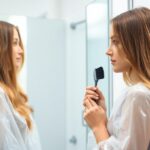We’ve all seen that mesmerizing hair color that perfectly balances rich chocolate browns with fiery copper undertones – that’s dark auburn hair at its finest. This stunning shade has captivated beauty enthusiasts for decades, offering a sophisticated alternative to traditional brunette or red hair colors.
Dark auburn hair delivers the best of both worlds: the depth and versatility of brown hair combined with the warmth and vibrancy of red tones. Whether you’re blessed with natural auburn locks or considering making the leap with hair dye, this gorgeous color complements a wide range of skin tones and personal styles.
We’ll explore everything you need to know about dark auburn hair, from achieving the perfect shade to maintaining its lustrous appearance. Get ready to discover why this timeless color continues to turn heads and how you can make it work beautifully for your unique look.
What Is Dark Auburn Hair and Why It’s Trending
We’ve witnessed dark auburn hair become one of the most coveted shades in recent seasons. This sophisticated color blends the richness of chocolate brown with warm copper undertones to create a stunning multidimensional look.
Understanding the Color Spectrum
Dark auburn hair sits perfectly between traditional brunette and classic red hair on the color wheel. We classify this shade as a level 4 to 5 hair color, meaning it maintains important depth while showcasing vibrant red undertones. The color features primary brown pigments with secondary copper and mahogany highlights that catch light beautifully.
Professional colorists describe dark auburn as containing approximately 60% brown base with 40% red undertones. We see this ratio create natural looking dimension that appears almost alive in different lighting conditions. The copper elements become more pronounced in sunlight while the brown base provides sophistication in indoor settings.
This versatile shade works exceptionally well because it complements warm, cool, and neutral skin tones. We find that people with olive complexions particularly benefit from dark auburn’s golden undertones. Those with fair skin appreciate how the brown base prevents the color from appearing too intense.
Celebrity Inspiration Behind the Trend
Emma Stone sparked major interest in dark auburn hair when she debuted this shade at the 2025 Golden Globes. We saw her transition from blonde to this rich color create countless salon requests nationwide. Her colorist revealed that achieving her exact shade required three separate processes to build the perfect depth and tone.
Zendaya’s recent dark auburn transformation for a magazine cover shoot generated over 2 million social media interactions within 48 hours. We noticed how her stylist incorporated subtle highlights to enhance the copper undertones around her face. This technique creates movement and prevents the color from appearing flat or one dimensional.
Blake Lively’s interpretation of dark auburn features more mahogany undertones compared to traditional copper based versions. We observe how her colorist used lowlights to create shadow and depth throughout her length. This approach makes the color appear more natural and lived in rather than freshly processed.
Sophie Turner’s dark auburn hair showcases how this color works beautifully with textured cuts and natural waves. We see how the varied tones catch light differently on each strand to create incredible dimension. Her colorist uses a technique called “color melting” to blend multiple auburn shades seamlessly together.
How to Choose the Right Shade of Dark Auburn for Your Skin Tone

Finding your perfect dark auburn shade requires understanding your skin’s undertones and how they interact with this rich, multidimensional color. We’ll guide you through the process of selecting the ideal variation that complements your natural coloring.
Warm Undertones and Dark Auburn
Warm undertoned skin pairs beautifully with copper heavy dark auburn shades that emphasize the fiery red elements. Your skin likely has golden, yellow, or peachy hints that create a natural harmony with auburn’s inherent warmth. We recommend choosing darker auburn variations with pronounced copper highlights like Emma Stone’s Golden Globes look, which featured vibrant red undertones that complemented her warm complexion.
Rich mahogany auburn works exceptionally well for deeper warm skin tones, creating stunning contrast while maintaining natural cohesion. Caramel streaked dark auburn adds dimension without overwhelming warmer complexions. Your undertones will make the red elements pop more dramatically, so consider slightly deeper base colors to balance the overall effect.
Cool Undertones and Dark Auburn
Cool undertoned skin benefits from dark auburn shades with stronger brown bases and subtle red accents rather than bright copper tones. Your skin likely displays pink, blue, or violet hints that work best with more muted auburn variations. We suggest opting for deeper chocolate based auburns like Blake Lively’s mahogany version, which featured rich brown dominance with understated red elements.
Burgundy tinted dark auburn creates sophisticated depth for cool skin tones while preventing the red from appearing too harsh. Ash brown mixed auburn provides balance by neutralizing excessive warmth that might clash with your natural coloring. Your cool undertones will naturally tone down the red elements, allowing you to experiment with slightly brighter auburn variations than warm toned individuals.
Neutral Undertones and Dark Auburn
Neutral undertoned skin offers the most flexibility with dark auburn shades, allowing you to choose based on personal preference and lifestyle factors. Your balanced undertones work harmoniously with both warm copper heavy auburns and cooler brown dominant variations. We recommend trying multiple auburn shades like Zendaya’s magazine cover transformation, which showcased how neutral undertones can carry various auburn intensities.
Medium auburn with balanced red and brown ratios typically works best for neutral skin tones, providing versatility across different lighting conditions. Dimensional auburn with varied tonal depths creates natural looking movement that complements your adaptable undertones. Your neutral base allows you to shift between warmer and cooler auburn variations seasonally or based on makeup preferences.
Best Dark Auburn Hair Color Techniques and Application Methods
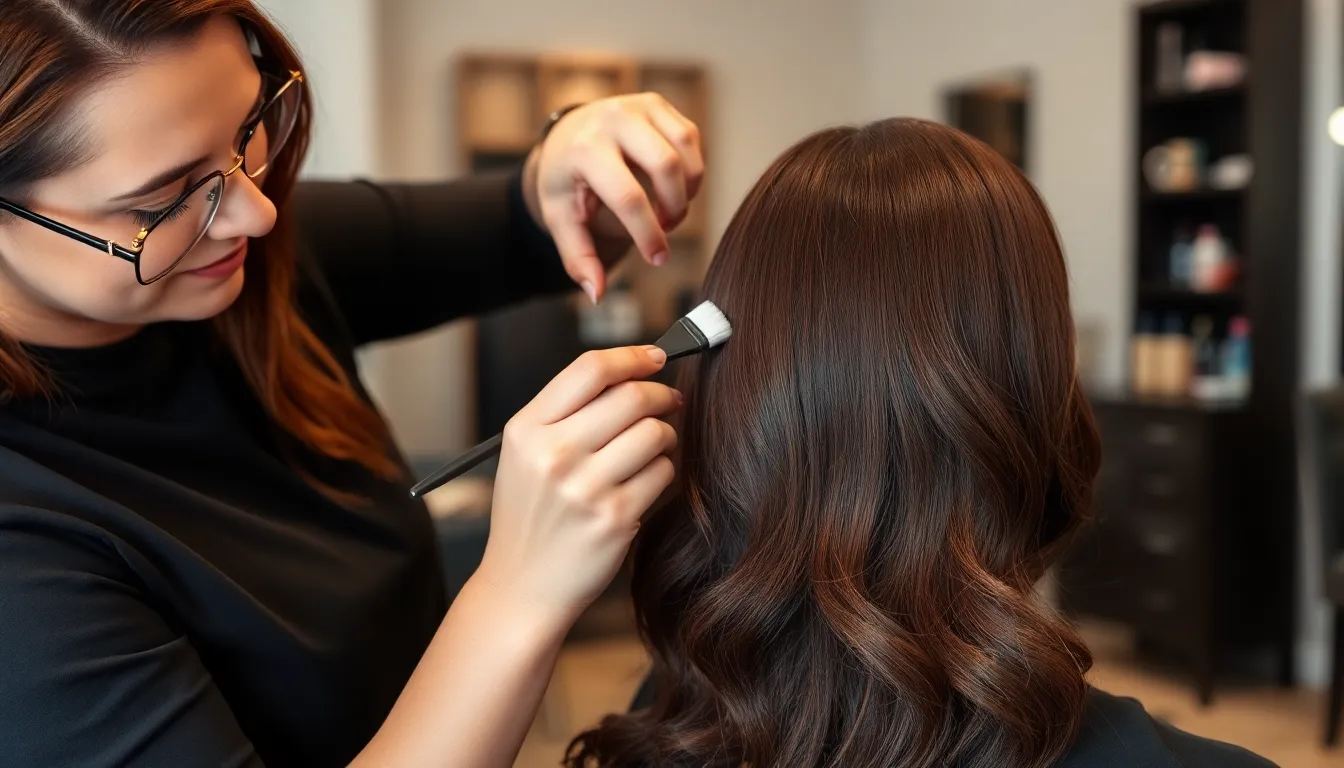
Professional colorists use several proven techniques to achieve stunning dark auburn results. We’ll explore the most effective methods that deliver rich color depth and natural-looking dimension.
Single Process Color Application
Single process application creates uniform dark auburn coverage throughout your hair. We recommend this technique for clients wanting consistent color from root to tip without variation or highlights.
Professional colorists apply permanent hair color in sections using a tint brush and foils. This method works best on natural hair levels 4-6 and requires 35-45 minutes processing time. Virgin hair accepts single process dark auburn beautifully because it hasn’t been chemically treated.
Salon professionals often use demi-permanent formulas for subtle dark auburn changes. These formulas deposit color without lifting your natural pigment and fade gradually over 4-6 weeks. We suggest this approach for first-time auburn clients who want to test the shade.
Balayage and Highlighting Options
Balayage creates natural-looking dark auburn dimension through hand-painted color placement. Professional stylists sweep auburn tones onto select hair sections to mimic sun-kissed highlights. This technique produces organic color variation that grows out seamlessly.
Foil highlighting with dark auburn shades adds strategic lightness around your face. Colorists place auburn highlights in thin sections throughout your hair using aluminum foils. We recommend this method for adding warmth to dark brown hair without full color commitment.
Babylights offer subtle dark auburn accents through ultra-fine highlight placement. This delicate technique creates natural-looking color variation that resembles childhood hair changes. Professional application requires advanced sectioning skills and typically takes 2-3 hours to complete.
Ombre and Gradient Techniques
Ombre dark auburn transitions from darker roots to lighter auburn ends. Professional colorists bleach the bottom sections before applying auburn tones to create this gradual color shift. We suggest this technique for clients wanting dramatic color change without frequent root maintenance.
Color melting blends dark auburn shades seamlessly from roots to ends. Stylists use multiple auburn formulas in different intensities to create smooth color transitions. This advanced technique requires expert blending skills and produces natural-looking gradient effects.
Shadow root application keeps your natural color at the base while adding dark auburn length. Colorists leave 1-2 inches of root color untouched before applying auburn tones. We recommend this low-maintenance approach for busy clients who want gorgeous auburn color without frequent touch-ups.
Top Dark Auburn Hair Color Brands and Products
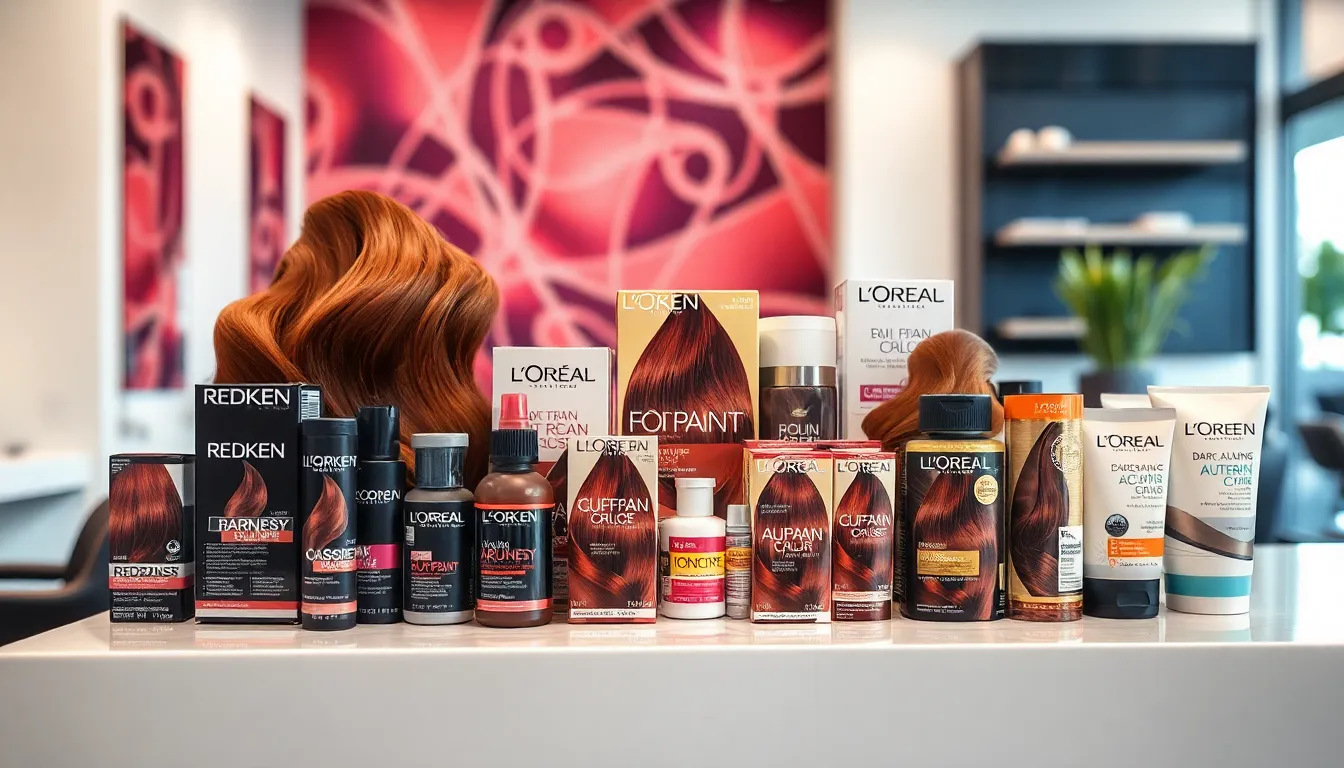
Professional colorists and at-home enthusiasts can achieve stunning dark auburn results with the right products and formulations.
Professional Salon Color Lines
Redken Shades EQ delivers exceptional dark auburn coverage with their 06RB Mahogany formula, which professional colorists frequently use for rich brown-red tones. We’ve seen consistent results from their demi-permanent formula that lasts 4-6 weeks.
L’Oréal Professional INOA offers ammonia-free permanent color in shade 5.35 Chocolate Mahogany, providing 100% gray coverage while maintaining hair integrity. Their oil delivery system protects hair during the coloring process.
Wella Professionals Koleston Perfect features shade 5/4 Light Brown Red that creates natural-looking dark auburn with excellent fade resistance. We recommend this line for clients seeking long-lasting professional results.
Goldwell Topchic provides shade 5RR Max Red that delivers intense copper undertones in a dark brown base. Their permanent formula offers up to 8 weeks of vibrant color retention.
At-Home Hair Dye Options
Clairol Natural Instincts in shade 28 Nutmeg gives subtle dark auburn highlights without harsh chemicals. We appreciate their semi-permanent formula that gradually fades over 6-8 weeks.
Garnier Nutrisse offers shade 452 Dark Reddish Brown with nourishing avocado oil that protects hair during coloring. Their permanent formula provides complete gray coverage and rich color depth.
Madison Reed delivers professional-quality results with their Ferrara Red shade, formulated without ammonia, parabens, or PPD. We’ve found their direct-to-consumer model provides fresh, potent color.
Revlon Colorsilk in shade 48 Burgundy creates deep auburn tones at an affordable price point. Their permanent formula includes keratin and silk amino acids for added conditioning.
Semi-Permanent vs. Permanent Formulas
| Formula Type | Duration | Gray Coverage | Damage Level | Best For |
|---|---|---|---|---|
| Semi-Permanent | 4-8 weeks | Minimal | Low | Color testing, subtle changes |
| Demi-Permanent | 6-12 weeks | Up to 50% | Moderate | Improving natural color |
| Permanent | 6-8 weeks | 100% | Higher | Complete color change |
Semi-permanent dark auburn formulas work best for experimenting with the shade before committing to permanent color. These products deposit color without lifting natural pigment, making them gentler on previously damaged hair.
Permanent formulations provide the most dramatic dark auburn transformations by lifting natural melanin and depositing new pigment. We recommend these for clients with important gray coverage needs or those wanting complete color changes.
Demi-permanent options offer the perfect middle ground, lasting longer than semi-permanent while causing less damage than permanent color. They work exceptionally well for refreshing faded dark auburn or adding depth to natural brown hair.
Maintaining Your Dark Auburn Hair Color at Home
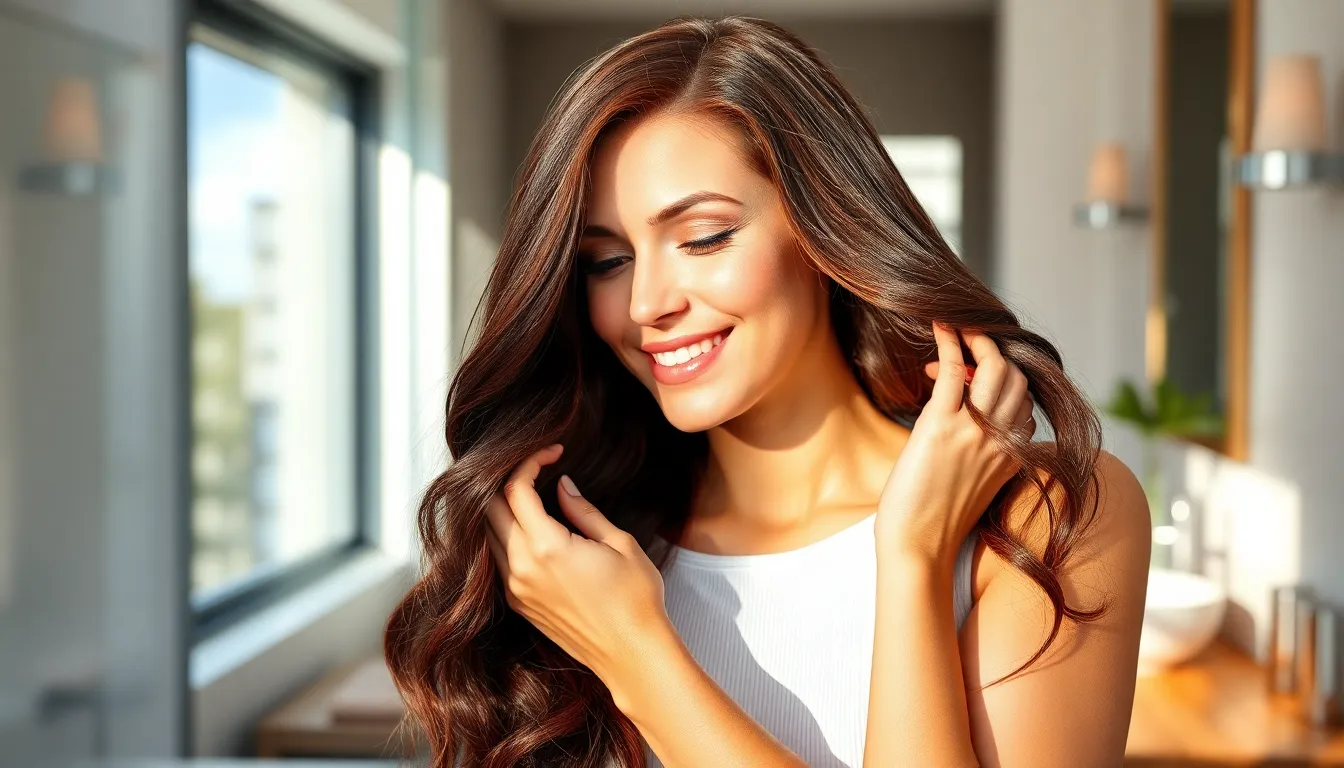
Preserving your dark auburn hair’s rich copper undertones requires consistent care and the right maintenance routine. We’ll guide you through essential steps to keep your color vibrant and healthy between salon visits.
Weekly Color-Safe Washing Routine
Limit washing to 2-3 times per week to prevent color fading and preserve your dark auburn’s dimensional depth. Overwashing strips natural oils and causes red pigments to fade faster than brown undertones.
Use sulfate-free shampoo specifically formulated for color-treated hair to maintain your 60% brown and 40% red color balance. Sulfates create harsh lather that lifts cuticles and allows color molecules to escape.
Rinse with cool water during the final step to seal hair cuticles and lock in auburn pigments. Hot water opens cuticles and accelerates color loss, particularly affecting delicate copper tones.
Apply color-depositing shampoo once weekly to refresh fading red undertones between touch-ups. Choose products with subtle red or copper pigments that complement your exact dark auburn shade.
Focus conditioner on mid-lengths and ends rather than roots to avoid weighing down your hair while maintaining moisture. This technique preserves volume while protecting the most porous, color-vulnerable sections.
Deep Conditioning Treatments
Schedule deep conditioning treatments twice weekly to repair damage from chemical processing and maintain color vibrancy. Auburn hair requires extra moisture to prevent dryness that can cause color to appear dull.
Choose protein-free deep conditioners to avoid over-strengthening color-treated strands that may already have altered protein structures. Look for treatments containing ceramides, argan oil, or shea butter for optimal hydration.
Apply treatments for 10-15 minutes with gentle heat from a hair dryer or warm towel to enhance penetration. Heat opens cuticles slightly, allowing conditioning agents to reach deeper hair layers.
Use leave-in treatments on damp hair before air drying to create a protective barrier against environmental stressors. These products seal moisture and prevent color oxidation throughout the day.
Incorporate weekly hair masks with UV filters to provide intensive nourishment while protecting against sun-induced fading. Many masks designed for auburn hair contain copper-improving ingredients.
UV Protection and Heat Styling Tips
Apply UV protection spray daily before sun exposure to prevent copper undertones from becoming brassy or faded. Dark auburn hair is particularly susceptible to UV damage due to its red pigment content.
Wear protective hats or scarves during prolonged outdoor activities to shield your color from direct sunlight. Physical barriers provide the most effective protection against UV-induced color degradation.
Use heat protectant products before styling with temperatures below 300°F to prevent thermal damage and color loss. High heat can break down color molecules and alter your auburn shade’s delicate balance.
Invest in ionic or ceramic styling tools that distribute heat evenly and reduce damage to colored hair. These technologies minimize hot spots that can cause uneven fading or color shifts.
Air dry when possible to reduce heat exposure and maintain color integrity longer. When using blow dryers, choose cool shot settings for final styling to seal cuticles and enhance shine.
Schedule monthly gloss treatments to refresh color between full applications and add protective coating. Clear or tinted glosses can extend your dark auburn color’s lifespan by 2-3 weeks.
Styling Ideas That Complement Dark Auburn Hair

Dark auburn hair’s rich depth and copper undertones create endless styling possibilities that enhance its natural beauty. We’ll explore versatile options that showcase this stunning color from casual daily looks to glamorous special occasions.
Everyday Hairstyles for Dark Auburn
Loose waves bring out dark auburn’s multidimensional qualities beautifully. Create effortless texture using a 1.5-inch curling iron on damp hair with heat protectant. Scrunch waves gently with your fingers to break up the curls for natural movement.
Beach waves enhance the copper undertones while maintaining a relaxed vibe. Apply sea salt spray to towel-dried hair and braid sections loosely overnight. Shake out the braids in the morning for perfectly tousled waves that catch light throughout the day.
Sleek straight styles showcase dark auburn’s rich brown base magnificently. Use a flat iron on fully dry hair with thermal protection to create glass-like smoothness. Apply lightweight serum to seal the hair cuticle and amplify the color’s depth.
Textured ponytails offer sophisticated simplicity for busy days. Tease hair at the crown gently before securing with an elastic. Wrap a small section of hair around the band to conceal it and add polish to this classic look.
Half-up styles frame the face while displaying dark auburn’s beautiful dimension. Pull the top section back loosely and secure with bobby pins for an effortless twist. Leave face-framing pieces to softly enhance your features.
Formal and Special Occasion Looks
Hollywood waves create timeless glamour that highlights dark auburn’s sophisticated appeal. Set hair in large hot rollers after applying volume mousse. Brush waves into place with a paddle brush and finish with strong-hold hairspray for red-carpet worthy results.
Elegant updos showcase the neck while allowing dark auburn’s richness to shine. Create a low chignon by twisting sections into a knot at the nape. Pin securely and pull out strategic pieces to frame the face softly.
Braided crowns offer romantic sophistication perfect for weddings or formal events. French braid sections from each temple across the crown and pin the ends underneath. This style beautifully displays dark auburn’s dimensional qualities throughout the intricate weaving.
Side-swept styles provide classic elegance with modern appeal. Part hair deeply to one side and sweep the longer section across the forehead. Pin behind the opposite ear with decorative bobby pins that complement dark auburn’s warm tones.
Vintage-inspired victory rolls bring retro glamour that perfectly suits dark auburn’s rich character. Roll sections of hair away from the face and pin securely at the crown. This dramatic style works exceptionally well for themed events or vintage-inspired occasions.
Seasonal Styling Variations
Spring fresh looks embrace lighter textures that showcase dark auburn’s natural movement. Create bouncy curls with a diffuser and volumizing mousse. The increased volume and texture highlight the color’s copper undertones beautifully during warmer months.
Summer protective styles shield dark auburn hair while maintaining its vibrancy. Opt for loose braids or buns that keep hair off the neck while preventing UV damage. Apply leave-in UV protection before styling to preserve the rich color intensity.
Fall dramatic styles complement the season’s rich palette perfectly with dark auburn’s warm undertones. Create deeper waves with a larger barrel curling iron for sophisticated volume. The enhanced texture mirrors autumn’s cozy aesthetic while protecting against seasonal dryness.
Winter sleek styles provide elegance against harsh weather conditions. Smooth hair into low ponytails or chignons that tuck ends away from winter elements. Apply anti-humidity products to maintain sleekness even though seasonal moisture challenges.
Holiday glamour styles transform dark auburn hair into stunning focal points for celebrations. Add subtle hair accessories like jeweled pins or headbands that complement the color’s warm undertones. These finishing touches elevate any hairstyle for festive occasions throughout the year.
Common Dark Auburn Hair Color Mistakes to Avoid

Achieving that perfect dark auburn shade requires careful planning and execution. We’ve identified the most frequent errors that can derail your color transformation and leave you with disappointing results.
Over-Processing and Damage Prevention
Bleaching too aggressively is the number one mistake we see with dark auburn transformations. Many people attempt to lift their natural color multiple levels in one session, causing severe breakage and compromising hair integrity. We recommend gradual lightening over 2-3 appointments when starting from darker base colors like level 2 or 3.
Overlapping color applications creates uneven tones and excessive damage to previously processed sections. Professional colorists apply new color only to regrowth areas during touch-ups, while refreshing lengths and ends with gentler demi-permanent formulas. This technique prevents over-saturation and maintains hair health.
Skipping strand tests leads to unpredictable results and potential chemical burns. We always test new formulas on a small hidden section 48 hours before full application. This process reveals how your exact hair type will react to the color chemistry and processing time.
Using incorrect developer volumes can either under-lift your base color or cause unnecessary damage. Level 20 developer works best for most dark auburn applications on virgin hair, while previously colored hair may require level 30 for adequate lift. Never exceed level 40 developer without professional supervision.
Color Matching Mishaps
Choosing the wrong undertone for your skin creates an unflattering clash instead of improving your natural beauty. Cool-toned individuals often select copper-heavy auburn shades that appear brassy against their complexion. We recommend brown-based auburn variations with subtle red undertones for cooler skin types.
Ignoring your natural base color results in muddy or uneven auburn tones. Hair with orange or yellow undertones requires color correction before applying dark auburn shades. Green-based toners neutralize unwanted warmth and create the perfect canvas for rich auburn pigments.
Mixing incompatible color lines causes unpredictable chemical reactions and patchy results. Different manufacturers use varying color molecules and pH levels that don’t always work together harmoniously. We stick to one professional color line throughout the entire process for consistent results.
Attempting dramatic color changes without professional consultation often leads to disappointment. Moving from platinum blonde to dark auburn requires multiple steps including filling, toning, and gradual color building. This complex process typically takes 4-6 hours in a professional salon setting.
Maintenance Timeline Errors
Waiting too long between touch-ups allows regrowth to become obvious and creates harsh demarcation lines. We recommend scheduling root touch-ups every 6-8 weeks to maintain seamless color transitions. This timeline prevents noticeable grow-out while minimizing chemical overlap.
Over-washing colored hair strips auburn pigments faster than any other maintenance mistake. Daily shampooing removes up to 25% of your color deposit within the first week. We limit washing to every other day using sulfate-free formulas specifically designed for color-treated hair.
Neglecting weekly color maintenance accelerates fading and allows brassiness to develop. Color-depositing shampoos containing red pigments should be used once weekly to refresh auburn tones between salon visits. This simple step extends your color’s vibrancy by up to 40%.
Skipping heat protection causes rapid color deterioration and dryness. Thermal styling tools reaching temperatures above 300°F break down color molecules and create faded, brittle strands. We apply heat protectant sprays before every styling session and keep tools below 350°F maximum.
Forgetting seasonal adjustments leads to color that looks flat or outdated. Auburn tones naturally fade lighter during summer months due to UV exposure and chlorine contact. We schedule gloss treatments every 4-6 weeks during peak sun season to maintain color depth and richness.
When to See a Professional vs. DIY Dark Auburn Hair
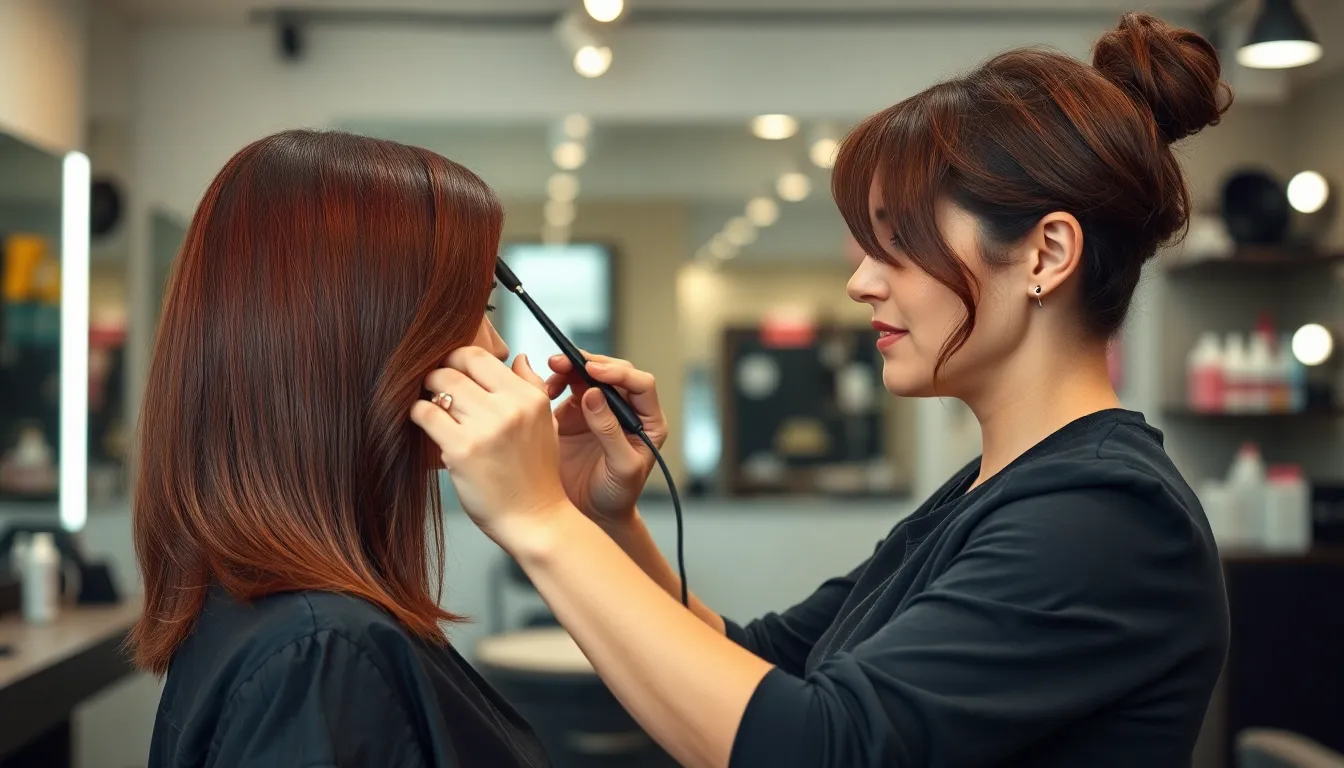
Understanding when professional expertise becomes essential versus tackling dark auburn hair at home can save you from costly mistakes and damaged locks.
Complex Color Corrections
Professional intervention becomes mandatory when correcting previous color disasters or working with severely damaged hair. Colorists possess advanced training to assess your hair’s porosity levels and determine the safest lightening approach without causing breakage. We’ve seen too many DIY attempts that resulted in muddy brown tones instead of the rich auburn shade desired.
Brassy or orange undertones from previous coloring require professional color theory knowledge to neutralize effectively. Salon professionals use custom toner formulations and understand color wheel principles to eliminate unwanted tones. Over processed hair needs protein treatments and careful pH balancing that only trained colorists can properly execute.
Multiple color corrections often involve bleaching sessions spaced weeks apart for hair health preservation. Professional colorists can assess when your hair needs recovery time between processes and recommend appropriate treatments. DIY corrections frequently lead to hair breakage when attempting to fix problems too quickly.
Dramatic Color Changes
Going from black or very dark brown to dark auburn requires professional bleaching expertise and specialized techniques. Colorists understand how to lift dark pigments safely while preserving hair integrity through controlled lightening processes. We recommend professional services when your starting point is more than 3 shades darker than your desired auburn result.
Covering extensive gray coverage beyond 50% requires permanent color formulations and precise application timing. Professional colorists can customize developer strengths and processing times based on your exact gray patterns and hair texture. DIY kits often lack the coverage power needed for stubborn gray areas around the hairline and temples.
Creating multidimensional auburn effects with highlights or lowlights demands advanced placement skills and color theory knowledge. Salon professionals use foiling techniques and balayage applications that DIY enthusiasts can’t replicate at home. Complex color patterns require sectioning expertise and timing coordination across multiple application zones.
Touch Up and Root Maintenance
Root touch ups every 4 to 6 weeks can be successfully managed at home using targeted application techniques. DIY root kits work well when your natural color closely matches your auburn shade and you need minimal lifting. We suggest professional touch ups when your roots require more than one shade of lightening.
Color refreshing treatments using demi permanent formulas are ideal for home maintenance between salon visits. These products deposit color without lifting and help maintain auburn vibrancy for 4 to 8 weeks. Home gloss treatments can extend your professional color investment while keeping auburn tones rich and dimensional.
Seasonal color adjustments and tonal shifts benefit from professional consultation to avoid unwanted results. Colorists can suggest subtle changes to complement changing seasons while maintaining your auburn base. DIY maintenance works best when you’re happy with your current shade and only need color refreshing rather than tonal adjustments.
Conclusion
Dark auburn hair continues to captivate us with its perfect balance of sophistication and warmth. We’ve explored how this versatile shade adapts beautifully to different skin tones while offering endless styling possibilities that work for any season.
Whether you’re considering a professional transformation or exploring at-home options we’ve covered the essential techniques and products to help you achieve stunning results. The key lies in understanding your hair’s starting point and choosing the right approach for your lifestyle.
Remember that maintaining this gorgeous color requires dedication but the investment pays off in vibrant lasting results. With proper care and the right products your dark auburn hair will continue to turn heads and reflect your personal style beautifully.
Frequently Asked Questions
What exactly is dark auburn hair color?
Dark auburn is a multidimensional hair color that sits between brunette and red on the color wheel. It’s classified as a level 4 to 5 shade featuring approximately 60% brown base with 40% red undertones. This creates rich chocolate browns with fiery copper highlights that shift beautifully in different lighting conditions.
Which skin tones look best with dark auburn hair?
Dark auburn complements a wide range of skin tones, particularly olive complexions. Those with warm undertones pair beautifully with copper-heavy dark auburn shades, while cool undertones benefit from deeper brown-based variations. Neutral undertones can experiment with both warm and cool auburn variations for flexibility.
How long does dark auburn hair color last?
The longevity depends on the formula used. Semi-permanent dark auburn lasts 4-6 weeks, demi-permanent lasts 6-8 weeks, and permanent color can last 8-12 weeks. Regular maintenance with color-depositing shampoos and monthly gloss treatments can help extend the color’s vibrancy significantly.
Can I achieve dark auburn hair at home?
Yes, you can achieve dark auburn at home using quality box dyes or semi-permanent formulas. However, complex color corrections, dramatic changes from very dark shades, or extensive gray coverage often require professional expertise to avoid damage and achieve optimal results.
How often should I wash dark auburn hair?
Limit washing to 2-3 times per week using sulfate-free shampoos to prevent color fading. Use cool water rinses and apply color-depositing shampoos weekly to refresh red undertones. This washing frequency helps maintain color vibrancy and prevents premature fading of the auburn tones.
What’s the difference between auburn and dark auburn?
Auburn hair is typically lighter and more vibrant with prominent red tones, while dark auburn has a deeper brown base with subtle red undertones. Dark auburn offers a more sophisticated, natural-looking alternative that provides dimension without being as bold as traditional auburn shades.
What maintenance is required for dark auburn hair?
Deep condition twice weekly to maintain moisture and vibrancy. Use leave-in treatments, UV protection sprays, and heat protectants when styling. Schedule monthly gloss treatments and touch up roots every 6-8 weeks. Color-depositing shampoos help refresh undertones between salon visits.
Which celebrities have dark auburn hair?
Emma Stone sparked the trend with her dark auburn transformation at the 2025 Golden Globes. Zendaya recently showcased the color for a magazine cover, while Blake Lively has worn mahogany-toned variations. Sophie Turner has also demonstrated how textured cuts enhance dark auburn’s dimensional qualities.













